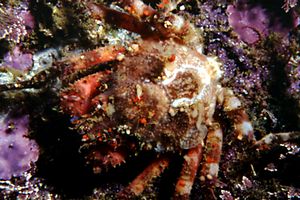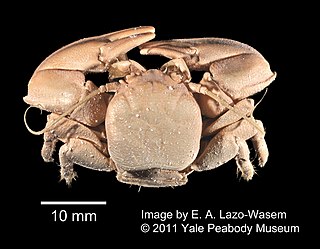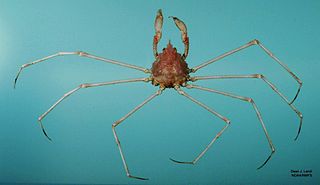
William Stimpson was an American scientist. He was interested particularly in marine biology. Stimpson became an important early contributor to the work of the Smithsonian Institution and later, director of the Chicago Academy of Sciences.

Littorinimorpha is a large order of snails, gastropods, consisting primarily of sea snails, but also including some freshwater snails and land snails.

Parthenopidae is a family of crabs, placed in its own superfamily, Parthenopoidea. It comprises nearly 40 genera, divided into two subfamilies, with three genera incertae sedis:

Palaemon is a genus of caridean shrimp in the family Palaemonidae.

Calappidae is a family of crabs containing 16 genera, of which 7 are only known as fossils:

Acanthocarpus is a genus in the family Asparagaceae, subfamily Lomandroideae, in the APG III system of classification. It has been difficult to place at family rank, being placed at various times in Dasypogonaceae as well as the Asparagaceae. The entire genus is endemic to the State of Western Australia.

Acanthocarpus preissii is a rhizomatous perennial flowering plant in the family Asparagaceae. It occurs on coastal dunes in Western Australia. White flowers appear between April and May in the species' native range.

Herbstia is a genus of crabs, containing the following eleven species:

The bathyal swimming crab, Bathynectes longispina, is a species of crab in the family Polybiidae.
Osachila is a genus of crabs in the family Aethridae, containing three fossil species, and the following extant species:

Leucosiidae is a family of crabs containing three subfamilies and a number of genera incertae sedis:

Micropanope is a genus of crabs in the family Pseudorhombilidae, containing one exclusively fossil species and the following species:

Petrolisthes eriomerus is a species of marine porcelain crab found in the eastern Pacific Ocean. It is commonly known as the flattop crab. It is a flattened, rounded animal, with a carapace up to 20 mm (0.8 in) across. It is a filter feeder, and also sweeps food from rocks.
Stephanasterias albula is a species of starfish in the family Asteriidae. It is the only species in its genus, Stephanasterias, which was described by Verrill in 1871. It has a circumboreal distribution and is found in the north west Atlantic Ocean, the north east Pacific Ocean, the Barents Sea and European waters. It usually has eight arms and is white with a rough upper surface. It has been trawled from depths of 267 metres.

The Panopeidae are a family containing 26 genera of morphologically similar crabs, often known as "mud crabs". Their centers of diversity are the Atlantic Ocean and eastern Pacific Ocean.

Pyromaia cuspidata, also known as the dartnose pear crab, is a species of crab in the family Inachoididae. This crab appears similar to Anasimus latus. It is a long-legged crab with a trident-shaped rostrum, and occurs in Atlantic waters from North Carolina to west Florida, and in the Gulf of Mexico through the Yucatán Peninsula down to Nicaragua. It is also found in Cuban waters. This species lives in depths of 27–549 metres (89–1,801 ft) on bottoms of mud, sand, or pebbles.

Pyromaia is a genus of crab in the family Inachoididae, containing the following species:
Mithraculus cinctimanus is a species of crab in the family Majidae. It is found in the Caribbean region and is usually associated with a sea anemone, sponge or coral.

Bathynectes is a genus of crabs in the family Polybiidae.

Euryplacidae is a family of crabs in the superfamily Goneplacoidea which contains the following genera:















